Motorcycle manufacturers continue to play it safe in the face of a still-strained economy, and perhaps there’s no surer sign of this than the limited number of wholly new motorbikes the major brands are rolling out for the 2012 model year.
Victory recently announced a couple new-ish models (Cross Country Tour and Cross Roads Classic LE), but in essence these new bikes are more or less iterations of existing bikes. The High-Ball, announced in January 2011, was issued as an early-release 2012 model and is perhaps the most-new model from Victory.
Harley-Davidson is also keeping risk to a minimum thus far for 2012 as it, too, has a limited amount of new product on the shelf. We recently reviewed the 2012 Dyna Switchback – a two-for-one bike, if you will, it’s the only machine that constitutes a new model from H-D.
But the Milwaukee-based bike maker also updated its V-Rod line.
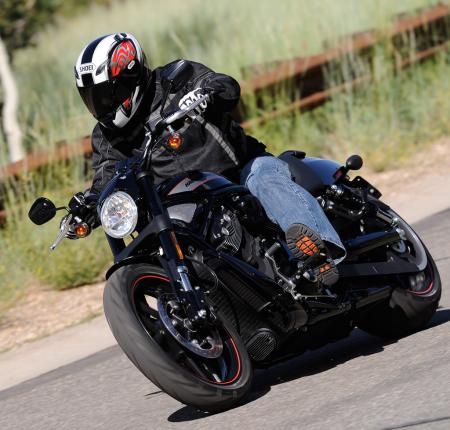 The V-Rod Night Rod Special received significant updates to rider ergos. However, this is one of only a handful of notable updates to the H-D line for the 2012 model year. The V-Rod Night Rod Special received significant updates to rider ergos. However, this is one of only a handful of notable updates to the H-D line for the 2012 model year. |
The 10th Anniversary V-Rod is a silvery version that pays homage to the original ‘Rod released 10 years ago, while the V-Rod Night Rod Special also went under the pen for its own improvements. Both motorcycles received a heavy dose of revision to rider ergos and some seriously lighter new wheels, among other enhancements. Look for an upcoming review covering both refreshed ‘Rods.
When it comes to bold new stuff from Harley, though, that’s the meat of it. However, H-D did grace several areas of its entire product lineup with some notable updates. Here’s a quick rundown of what’s new across the 2012 Harley-Davidson line.
Twin Cam 103 now standard on Touring, Softails and most Dynas
Several years ago the TC 103 was standard only on Harley’s in-house custom line known as CVO (Custom Vehicle Operations). While the CVO line now utilizes the Screamin’ Eagle 110 V-Twin, the 103 was otherwise only an available upgrade option on select models as late as last year. For 2012 the Twin Cam 103 is the standard mill in all Touring models, Softails and Dyna motorcycles, with the Dyna Street Bob and Dyna Super Glide Custom retaining the Twin Cam 96 in order to remain price-point models.
Harley claims the 103 makes as much as 6% more peak power than the Twin Cam 96’s claimed 94 hp at 3500 rpm.
The touring models also benefit from an oil cooler in order to offset the wind flow-limiting effects of the tourers’ additional bodywork (fairing lowers). Finally, the PowerPak – Twin Cam 103 upgrade option from 2011 – is eliminated for 2012, as a large portion of the lineup now has the TC103 as standard.
$1195 Security Package (Security System and ABS) – now also available on Dyna models
Harley’s ABS is no longer a standalone option, as it’s now coupled with Harley’s proximity-fob keyless ignition to create the Security Package option. The package remains as an option for V-Rods, Softails and various Touring models, with the following three models receiving the package as standard equipment: Road King Classic, Electra Glide Ultra Limited and Road Glide Ultra. Package pricing of $1195 remains the same as last year.
Touring models updates
In addition to the Twin Cam 103 for all touring models, other updates include a new front fairing wind deflector for the Road Glide Ultra, and new optional tubeless Chrome Profile laced (spoke) wheels.
This new tubeless aluminum rim utilizes a new rim seal and molded valve stem to allow use of tubeless tires. Along with the benefit of easier tire installation, this new tubeless wheel set also provides a 30% reduction in spin inertia according to Harley’s Bjorn Christensen. The obvious benefit of a lighter wheel is less rotational mass, which in turn means lighter effort steering/handling, as well as improved suspension control – all good things for you. This new wire wheel is available for all touring models except the Electra Glide Ultra Limited.
Softail models updates
The Softies get a smaller, less visually apparent exhaust and heated O2 sensors, and the tubeless Chrome Profile spoke wheel mentioned above for the touring line is also an option for the Softails.
Switchgear controls (High/Low Beam, Start button, Trip/Horn, etc.) receive a new “ergonomic” shape. Rather than having a smooth, rounded surface, the switches now have a slight concave shape at the top for improved tactile feel that better allows a rider to differentiate between the top and bottom of the switches. Additionally, a Flash-to-Pass button has been integrated to the left switchgear housing. Think of the pass toggle on most Euro bikes – same idea.
The Softail Fat Boy and Fat Boy Lo have a revised handlebar with less rise and milder bend in the grip area compared to model year 2011. The new shape reduces reach to the bar by 1.25 inches. Lastly, the Fat Boy Lo saddle is now also on the Fat Boy.
Sportster models updates
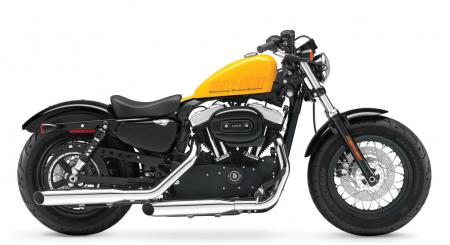 All Sporties will roll on Michelin tires in 2012. The Forty-Eight also gets slightly revised fuel tank graphics. All Sporties will roll on Michelin tires in 2012. The Forty-Eight also gets slightly revised fuel tank graphics. |
The flattrack racer replica XR1200X rolls on Michelin’s Scorcher 11 tires, while all XL models have the Scorcher 31 tire set. Sportster side covers are now either gloss black or denim black depending on the main color scheme.
Dyna models updates
The biggest news for the Dyna line other than the TC103 and addition of the Switchback is an updated and improved ABS.
While ABS on Dyna models is functionally equivalent to ABS on the other model lines that receive ABS, Harley tailored the system to the Dynas by way of reduced dimensions for a single electro-hydraulic control unit. And expanded diagnostics capability for the system means Harley could use one control module for both the front and rear brakes rather than separate units for each brake set.
Dyna bikes also enjoy an updated and more compact ECU and new electrical system. The electrical system is a CAN (Controller Area Network) system (BMW has used this type of system for a while), which uses less wiring and allows a high rate of data transfer – useful for complex systems like ABS that communicate lots and lots of info in the blink of an eye to the bike’s brain.
The new ergo-friendly switchgear seen on the Softails is also on Dyna models, as well as a new LCD tripmeter that now also includes a combo GPI/RPM indicator as one of its functions.

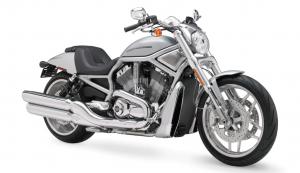 Have 10 years passed already since the V-Rod was introduced? Wow. This 2012 10th Anniversary V-Rod commemorates the introduction of the V-Rod in 2002.
Have 10 years passed already since the V-Rod was introduced? Wow. This 2012 10th Anniversary V-Rod commemorates the introduction of the V-Rod in 2002. 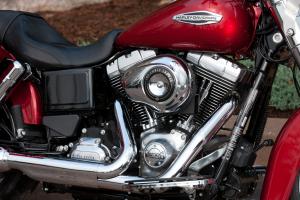 Along with the new Dyna Switchback joining Harley’s family of 32 motorcycles the other big news for 2012 from H-D is that the Twin Cam 103 now powers most Big Twin bikes.
Along with the new Dyna Switchback joining Harley’s family of 32 motorcycles the other big news for 2012 from H-D is that the Twin Cam 103 now powers most Big Twin bikes.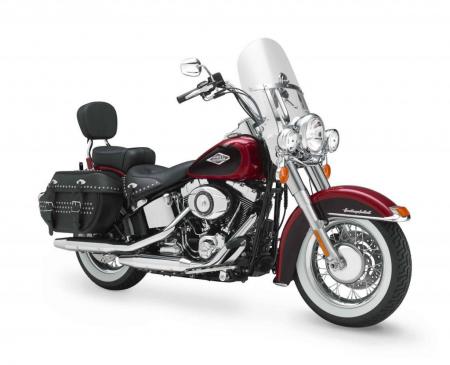 Harley's new, optional laced wheel, as seen here on the 2012 Softail Heritage Classic, allows use of tubeless tires. The new wheel is available as an option for the 2012 Touring family (except the Ultra Limited) and 2012 Softails.
Harley's new, optional laced wheel, as seen here on the 2012 Softail Heritage Classic, allows use of tubeless tires. The new wheel is available as an option for the 2012 Touring family (except the Ultra Limited) and 2012 Softails.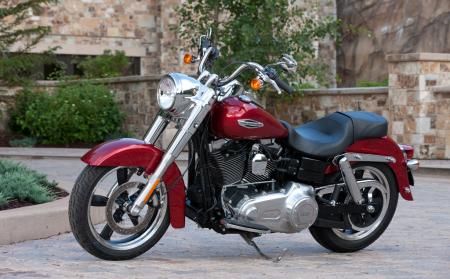 Here’s the Switchback stripped of its quick-release windscreen and hard saddlebags. With this bike as the only all-new model for 2012 from Harley it seems even the mighty Motor Company is remaining conservative as a dark cloud continues to linger over world economies.
Here’s the Switchback stripped of its quick-release windscreen and hard saddlebags. With this bike as the only all-new model for 2012 from Harley it seems even the mighty Motor Company is remaining conservative as a dark cloud continues to linger over world economies.






